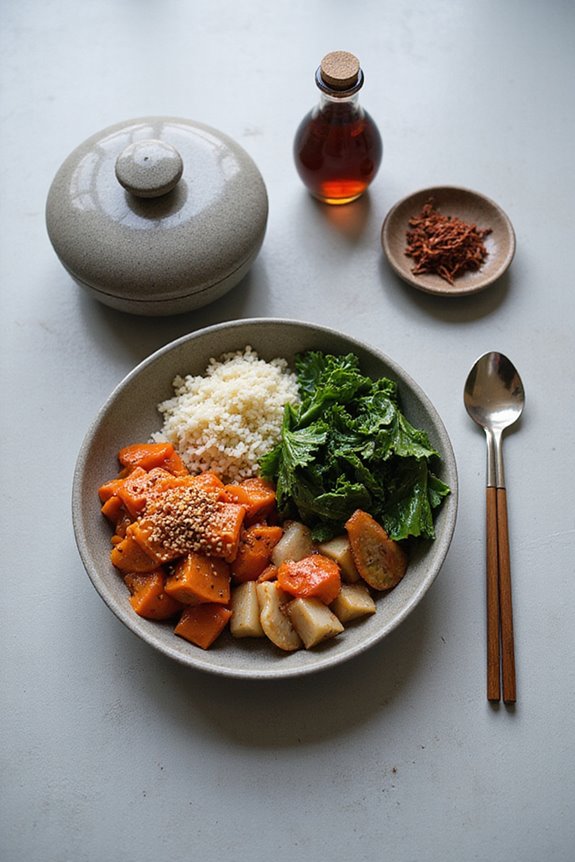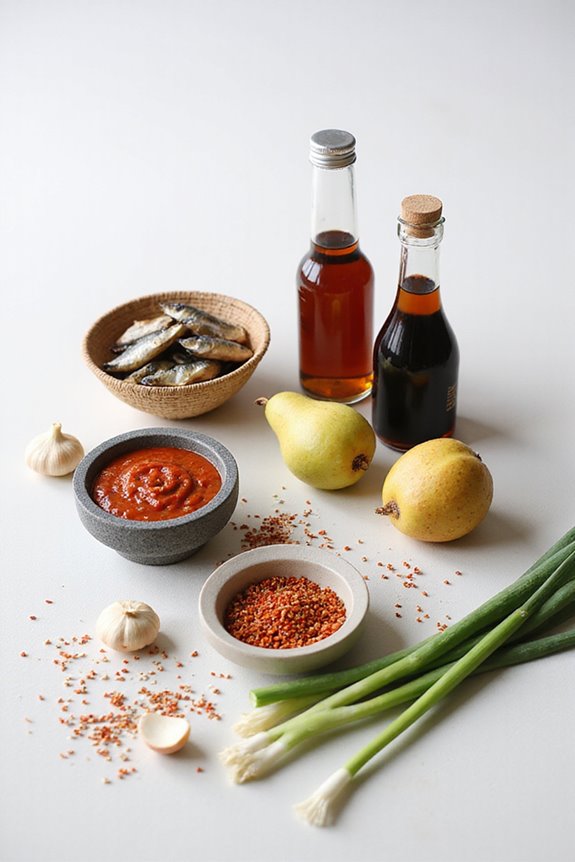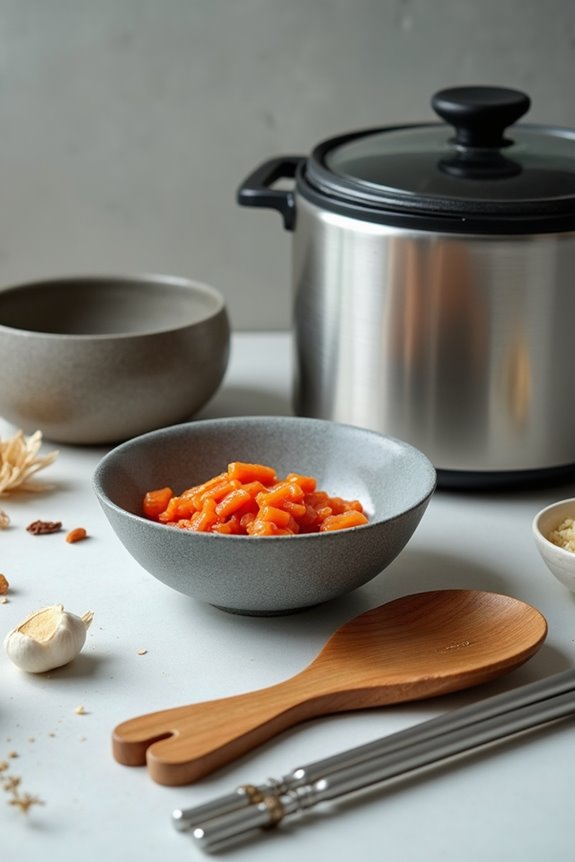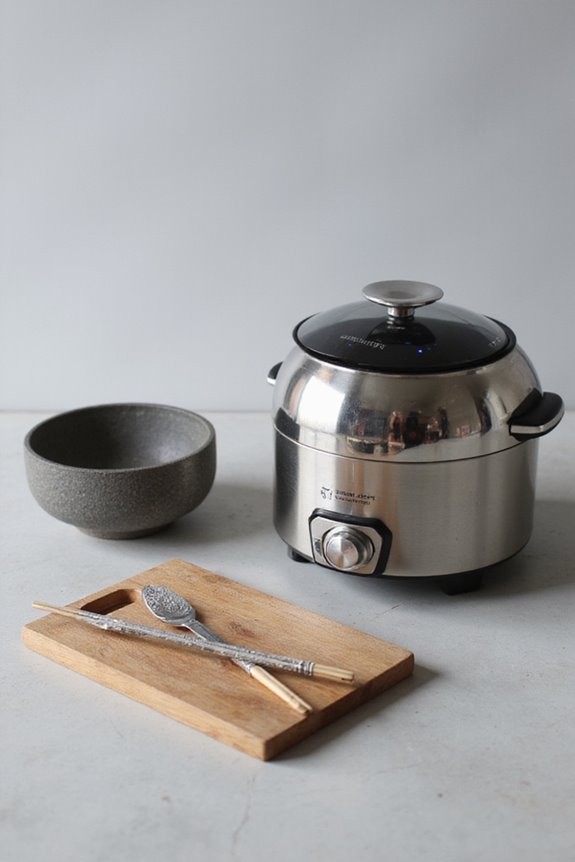Korean cooking traditions stem from agricultural and nomadic roots, utilizing techniques like boiling, steaming, fermentation, and grilling to achieve flavorful dishes. For instance, we often create rich soups through boiling, while grilling reflects our communal dining culture. Fermentation is essential for dishes like kimchi, enhancing taste and shelf life. Additionally, we emphasize marination with ingredients like soy sauce and gochujang to elevate flavors. These practices not only shape our culinary identity but also reveal fascinating trends in global cuisine.
Key Takeaways
- Korean cuisine originates from agricultural and nomadic practices, shaping traditional dishes and banchan through diverse crops and meat consumption.
- Boiling and steaming are fundamental cooking techniques, creating rich soups and optimizing flavor absorption and nutritional retention in meals.
- Fermentation plays a vital role in enhancing taste and preserving ingredients, exemplified through kimchi and traditional jars for developing sauces.
- Grilling is significant in Korean culture, promoting communal dining and hospitality while creating caramelized, juicy dishes through high heat.
- Marination is essential for flavor enhancement in Korean cooking, using ingredients like soy sauce and gochujang to tenderize and deepen flavors in proteins.
Agricultural and Nomadic Origins of Korean Cuisine
Although we often think of Korean cuisine as a contemporary phenomenon, its roots trace back thousands of years to both agricultural and nomadic origins. Early Korean societies practiced farming techniques during the Jeulmun pottery period, cultivating millet, barley, rice, and legumes. This shift toward agriculture led to a diverse array of crops that greatly influenced traditional dishes, with banchan emerging as fundamental components of meals. Meanwhile, nomadic traditions from tribes like the Maek, who hunted and consumed meat, shaped culinary practices. The introduction of marinated skewered meats, like maekjeok, illustrates how these lifestyles blended. As these nomadic groups settled, culinary techniques continued to adapt, evolving into the rich tapestry of flavors and dishes we recognize in vibrant Korean cuisine today.
The Art of Boiling and Steaming in Korean Cooking
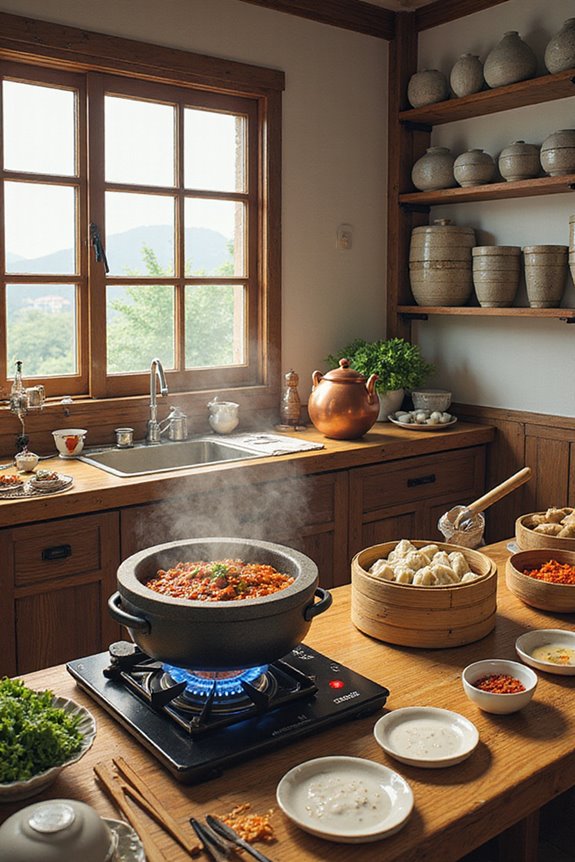
In Korean cooking, the art of boiling and steaming holds a significant place, as these methods bring out the natural flavors and nutritional benefits of ingredients. We use boiling techniques to create rich soups and stews, such as Doenjang Jjigae and Kimchi Jjigae, allowing flavors to meld over slow cooking. By boiling tough cuts of meat, we soften them, enhancing overall tenderness. Steaming, or jjim, preserves moisture and flavors without risk of overcooking, delivering healthier meals. Popular steamed dishes, like Gyeran Jjim, exemplify the versatility and texture achieved through steaming. In combining boiling and steaming, we optimize flavor absorption, nutritional retention, and enhance the sensory experiences of our traditional and modern dishes within Korean cuisine. Additionally, the use of smoke reduction technology in modern indoor grills can complement these cooking methods by providing a pleasant cooking experience without overwhelming smoke.
The Role of Fermentation and Preservation
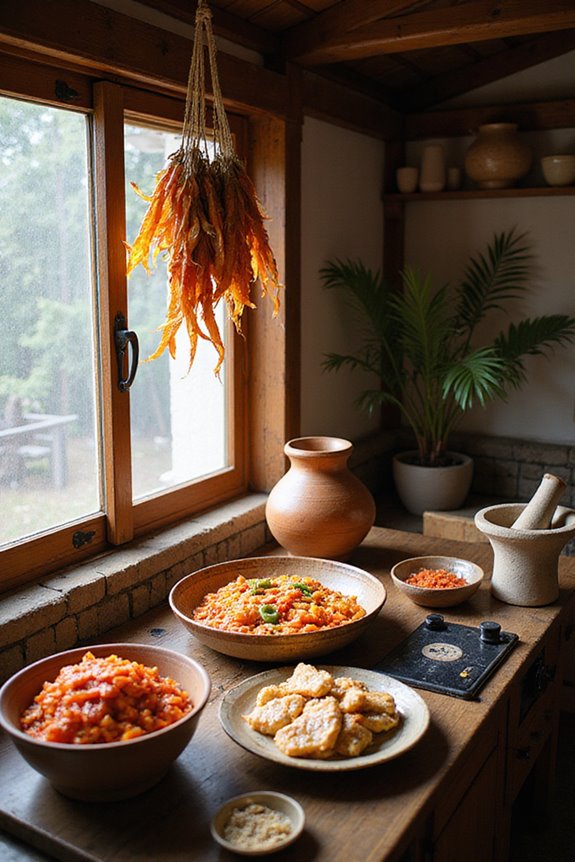
Fermentation and preservation serve fundamental roles in Korean cooking, enhancing not only the taste of our dishes but also their shelf life and nutritional value. We employ various fermentation techniques, such as salting vegetables for kimchi, which helps draw out water and create flavorful brine. Traditional jars, known as jangdok, are used to facilitate proper air circulation, essential for developing rich flavors in products like doenjang and ganjang. These preservation practices allow seasonal ingredients to be stored long-term, making them important in Korea’s historical context. For instance, kimchi can stay fresh for up to six months in refrigeration. Overall, the careful fermentation process improves both the taste and health benefits of our beloved foods, integral to our culinary heritage.
Grilling Techniques and Their Cultural Significance
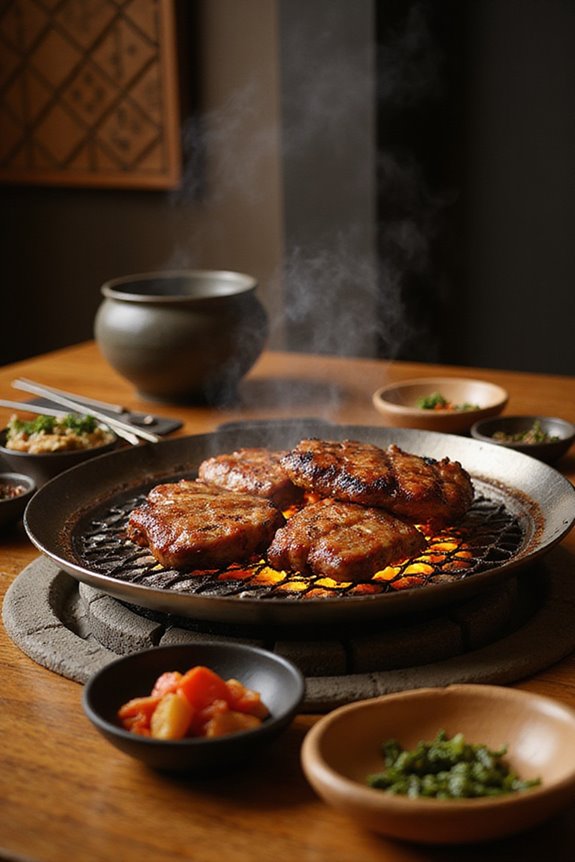
Grilling plays a central role in Korean cuisine, combining technique with cultural significance to create a unique dining experience. The practice of tabletop grilling is integral to communal dining, where diners engage in cooking together. This method fosters a collaborative atmosphere, as participants grill their meat over high heat, resulting in a caramelized exterior while maintaining juiciness. Additionally, grilling at the table enhances the experience by allowing diners to adjust heat levels and cooking times according to personal preferences. The act of sharing food and participating in the cooking process reflects core Korean values of hospitality and togetherness. Often reserved for special occasions, Korean BBQ symbolizes abundance, making it a cherished tradition within the culture. Many families enhance their grilling experience with authentic Korean seasonings that elevate the flavors of the meats and vegetables.
Marination: Enhancing Flavor in Korean Dishes
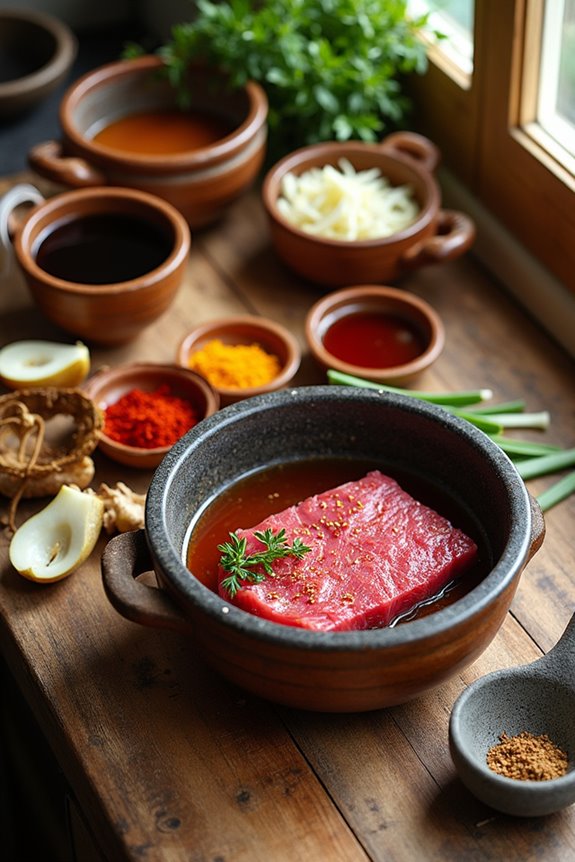
Marinating is essential in Korean cooking, as it greatly enhances the flavors of various dishes while also tenderizing proteins. We use marinade variations that often feature soy sauce, gochujang, and rice vinegar, which contribute depth, sweetness, and acidity, respectively. Ingredients like garlic and ginger are incorporated for aromatic elements, while fruits such as Asian pear may add a hint of sweetness. Different protein types require specific marination approaches; for instance, thinly sliced beef benefits from longer marination, while delicate shrimp need only brief soaking. The balance of sweetness can be achieved by adjusting sugar content. As we explore these techniques, we appreciate how thoughtful marination transforms simple ingredients into flavorful, traditional Korean dishes, improving both taste and texture.
Modern Adaptations and the Global Influence of Korean Cuisine
As globalization increases, we see Korean cuisine adapting to diverse cultural landscapes while maintaining its core elements. The rise of fusion flavors exemplifies this adaptation, as traditional Korean dishes merge with various international cuisines to create modern interpretations. Simply put, Korean food has moved beyond its origins, reflected in the growing number of high-end restaurants worldwide and increasing culinary diplomacy efforts. For example, Korea’s culinary courses taught in countries like Turkey introduce local chefs to integral techniques and flavors. Additionally, the Korean Wave, or Hallyu, has greatly fueled global interest, with Korean products and dishes reaching record export values. Overall, the dynamic nature of Korean cuisine reflects both cultural exchange and a thriving global market for unique flavors. Furthermore, ingredients like authentic kimchi seasoning mixes offer not only flavor but also enhance the nutritional value of dishes, making them appealing to health-conscious consumers.
Frequently Asked Questions
What Are the Staple Ingredients in Traditional Korean Cooking?
In traditional Korean cooking, we rely on staple grains like short-grain rice and soybeans. Fermented foods, such as gochujang and doenjang, add depth and flavor, enhancing every dish we create together.
How Are Traditional Korean Meals Typically Structured?
You know, our traditional Korean meals usually include rice, soups, and various banchan, served communally. The meal components boast a beautiful balance, while the serving styles encourage sharing, fostering connection and warmth among all of us.
What Is the Significance of Dining Etiquette in Korea?
Dining customs in Korea emphasize respect through table manners and etiquette. We’ve learned to honor elders and engage in communal sharing, fostering harmony. These practices strengthen our connections and show appreciation for the meal and each other.
Are There Any Health Benefits to Traditional Korean Cuisine?
Absolutely, traditional Korean cuisine offers numerous health benefits and high nutritional value. It’s rich in probiotics, vitamins, and minerals, promoting gut health and reducing chronic disease risks while improving our overall well-being and vigor.
How Do Regional Differences Affect Korean Cooking Styles?
Regional differences profoundly shape Korean cooking styles, influencing flavors and techniques. We experience diverse regional kimchi varieties, unique seafood dishes, and various cooking methods that reflect local ingredients, history, and culture—making each meal a unique culinary journey.

